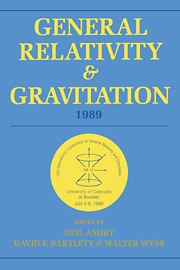 General Relativity and Gravitation, 1989
General Relativity and Gravitation, 1989 Book contents
- Frontmatter
- Contents
- Preface
- Conference committees
- Part A Classical relativity and gravitation theory
- WORKSHOPS
- Part B Relativistic astrophysics, early universe, and classical cosmology
- 5 Gravitational lenses: theory and interpretation
- 6 Recent observations of gravitational lenses
- 7 Inflation and quantum cosmology
- 8 Theory and implications of cosmic microwave background Radiation
- 9 The cosmic microwave background: present status of observations, and implications for general relativity
- WORKSHOPS
- Part C Experimental gravitation and gravitational wave detection
- WORKSHOPS
- Part D Quantum gravity, superstrings, quantum cosmology
- WORKSHOPS
- Part E Overviews-past, present, and future
5 - Gravitational lenses: theory and interpretation
Published online by Cambridge University Press: 05 March 2012
- Frontmatter
- Contents
- Preface
- Conference committees
- Part A Classical relativity and gravitation theory
- WORKSHOPS
- Part B Relativistic astrophysics, early universe, and classical cosmology
- 5 Gravitational lenses: theory and interpretation
- 6 Recent observations of gravitational lenses
- 7 Inflation and quantum cosmology
- 8 Theory and implications of cosmic microwave background Radiation
- 9 The cosmic microwave background: present status of observations, and implications for general relativity
- WORKSHOPS
- Part C Experimental gravitation and gravitational wave detection
- WORKSHOPS
- Part D Quantum gravity, superstrings, quantum cosmology
- WORKSHOPS
- Part E Overviews-past, present, and future
Summary
The theory of imaging of cosmologically distant point and extended sources, specifically quasars and galaxies by an intervening mass is described. Particular attention is paid to formalisms which allow one to understand the qualitative principles governing image formation. The importance of caustics is emphasized, particularly their role in the formation of highly magnified images. The prospects for measuring the Hubble constant and the cosmological density parameter are reviewed.
Introduction
The history of gravitational lensing is one in which general relativists can take some pride. The basic effect was anticipated by many researchers including Einstein (1936); Refsdal (1964); Press and Gunn (1973); Bour-rassa and Kantowski (1975); long before the discovery by Walsh, Car-swell and Weymann (1981) of the first convincing example of multiple imaging of a background quasar by an intervening galaxy. This is perhaps not too surprising since gravitational lensing is an almost trivial consequence of the general theory. What was surprising was how rich a field the elementary geometrical optics of gravitational lensing has become when stimulated by the observational discoveries reviewed here by Bernard Fort (Chapter 6, this volume). I intend to review some of the theoretical approaches to gravitational lenses that have been developed over the past ten years emphasizing those that are directly relevant to interpreting the observations.
Gravitational lenses have been heralded as important astronomical tools; specifically they are probes of the dark matter found in the outer parts of galaxies, rich clusters of galaxies and perhaps also the universe at large.
- Type
- Chapter
- Information
- General Relativity and Gravitation, 1989Proceedings of the 12th International Conference on General Relativity and Gravitation, pp. 133 - 152Publisher: Cambridge University PressPrint publication year: 1990


